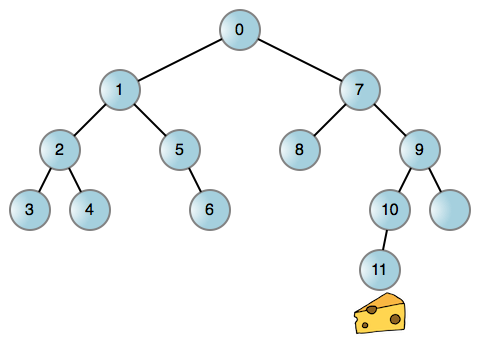

Let’s take a look at this classic recursive factorial:
#include int factorial(int n) { int previous = 0xdeadbeef; if (n == 0 || n == 1) { return 1; } previous = factorial(n-1); return n * previous; } int main(int argc) { int answer = factorial(5); printf("%d\n", answer); }
Recursive factorial - factorial.c
The idea of a function calling itself is difficult to grasp at first. In order to make this process more vivid and concrete, the following figure shows the situation of the endpoint on the stack when factorial(5) is called and the line of code n == 1 is reached:

Every call to factorial generates a new stack frame. The creation and destruction of these stack frames is what makes the recursive version factorially slower than its corresponding iterative version. The accumulation of these stack frames may exhaust stack space before the call returns, causing your program to crash.
These worries often exist in theory. For example, the stack frame takes 16 bytes for each factorial (this may depend on the stack arrangement and other factors). If you're running a modern x86 Linux kernel on your computer, you typically have 8 GB of stack space, so n in a factorial program can go up to about 512,000. This is a huge result, and it takes 8,971,833 bits to represent it, so stack space is not an issue at all: a tiny integer—even a 64-bit integer—is stored in our stack space. It has overflowed thousands of times before it ran out.
We will look at the use of CPU in a while. For now, let’s take a step back from bits and bytes and treat recursion as a general technology. Our factorial algorithm boils down to pushing the integers N, N-1, … 1 onto a stack and multiplying them in reverse order. We actually use a program call stack to achieve this, here are the details of it: we allocate a stack on the heap and use it. Although the call stack has special characteristics, it is just another data structure that you can use however you want. I hope this diagram helps you understand this.
When you think of the call stack as a data structure, something becomes clearer: piling up those integers and then multiplying them together is not a good idea. That's a flawed implementation: it's like taking a screwdriver to drive a nail. It is more reasonable to use an iterative process to calculate the factorial.
However, there are so many screws that we can only pick one. There is a classic interview question where there is a mouse in a maze and you have to help the mouse find a piece of cheese. Suppose a rat can turn left or right in a maze. How do you model to solve this problem?
Like many problems in real life, you can simplify this problem of mice looking for cheese into a graph, with each node of a binary tree representing a position in the maze. You can then have the mouse turn left wherever possible, and when it reaches a dead end, backtrack and turn right again. Here’s an example of a mouse walking a maze:

Every time it reaches the edge (line), let the mouse turn left or right to reach a new position. If you are blocked in any direction you turn, it means that the relevant edge does not exist. Now, let’s discuss it! This process, whether you use a call stack or other data structures, is inseparable from a recursive process. And using the call stack is very easy:
#include #include "maze.h" int explore(maze_t *node) { int found = 0; if (node == NULL) { return 0; } if (node->hasCheese){ return 1;// found cheese } found = explore(node->left) || explore(node->right); return found; } int main(int argc) { int found = explore(&maze); }
Recursive Maze Solving Download
When we find cheese in maze.c:13, the stack looks like this. You can also see more detailed data in the GDB output, which is the data collected using the command.

It demonstrates the good behavior of recursion because this is a problem suitable for using recursion. And it's no surprise: when it comes to algorithms, recursion is the rule, not the exception. It shows up when you're searching, when you're traversing trees and other data structures, when you're parsing, when you need to sort -- it's everywhere. Just as pi or e are known as "gods" in mathematics because they are the basis of everything in the universe, recursion is the same: it just exists in the structure of calculations.
What’s great about Steven Skienna’s excellent book A Guide to Algorithm Design is that he interprets his work through “war stories” as a means to demonstrate the algorithms behind solving real-world problems. This is the best resource I know for expanding your knowledge of algorithms. Another reading is McCarthy's original paper on LISP implementation. Recursion is both its name and its fundamental principle in the language. The paper is both readable and interesting, and it's exciting to see a master's work at work.
迷路の問題に戻りましょう。ここで再帰を残すのは困難ですが、コールスタックを通じてそれを達成しなければならないという意味ではありません。 RRLL のような文字列を使用してターンを追跡し、この文字列を使用してマウスの次の動きを決定できます。あるいは、チーズハントの全体的なステータスを記録するために何か他のものを割り当てることもできます。引き続き再帰的なプロセスを実装しますが、必要なのは独自のデータ構造を実装することだけです。
スタック呼び出しの方が適しているため、これはより複雑に思えます。各スタック フレームは、現在のノードだけでなく、そのノードでの計算の状態も記録します (この場合、左のみに移動させたか、右に移動しようとしたか)。したがって、コードは重要ではなくなりました。しかし、オーバーフローや期待されるパフォーマンスを恐れて、この優れたアルゴリズムを放棄してしまうことがあります。それは愚かです!
ご覧のとおり、スタック領域は非常に大きく、スタック領域が使い果たされる前に他の制限が発生することがよくあります。一方で、問題の規模をチェックして、問題を安全に処理できるかどうかを確認できます。 CPU への懸念は、広く流通している 2 つの問題例、ダム階乗と恐ろしい記憶のない O(2n) フィボナッチ再帰によって引き起こされています。これらはスタック再帰アルゴリズムを正しく表現したものではありません。
実際、スタック操作は非常に高速です。通常、データへのスタック オフセットは非常に正確で、キャッシュ内のホット データであり、特殊な命令がそのデータに対して動作します。同時に、ヒープ上に割り当てられた独自のデータ構造の使用に伴うオーバーヘッドも大きくなります。スタック呼び出し再帰よりも複雑でパフォーマンスの悪い実装メソッドを作成する人がよくいます。最後に、最新の CPU のパフォーマンスは非常に優れており、一般に CPU がパフォーマンスのボトルネックになることはありません。プログラムのパフォーマンスとそのパフォーマンスの測定について常に考えるのと同じように、プログラムの単純さを犠牲にすることを検討するときは注意してください。
次の記事はスタックの探索シリーズの最後の記事になります。テールコール、クロージャ、およびその他の関連概念について学びます。次に、私たちの古い友人である Linux カーネルに飛び込みます。読んでいただきありがとうございます!

The above is the detailed content of Recursive operations in software development. For more information, please follow other related articles on the PHP Chinese website!




